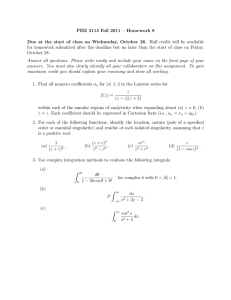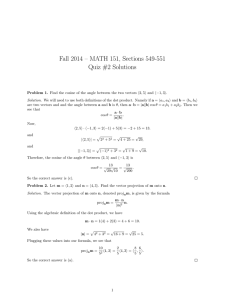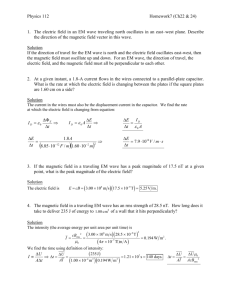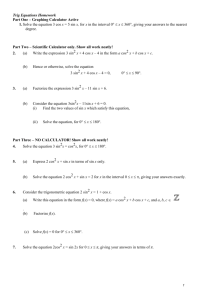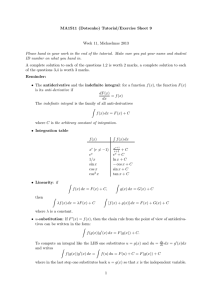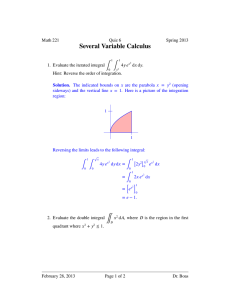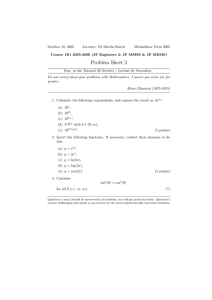Electronic Journal of Differential Equations, Vol. 2015 (2015), No. 14,... ISSN: 1072-6691. URL: or
advertisement
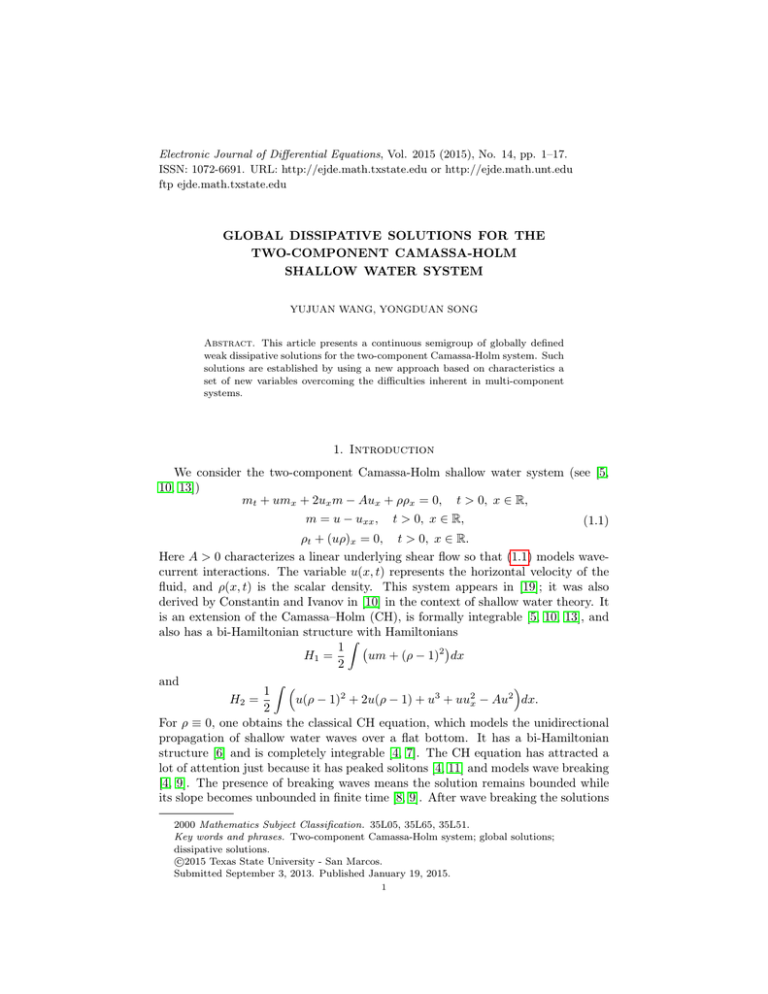
Electronic Journal of Differential Equations, Vol. 2015 (2015), No. 14, pp. 1–17.
ISSN: 1072-6691. URL: http://ejde.math.txstate.edu or http://ejde.math.unt.edu
ftp ejde.math.txstate.edu
GLOBAL DISSIPATIVE SOLUTIONS FOR THE
TWO-COMPONENT CAMASSA-HOLM
SHALLOW WATER SYSTEM
YUJUAN WANG, YONGDUAN SONG
Abstract. This article presents a continuous semigroup of globally defined
weak dissipative solutions for the two-component Camassa-Holm system. Such
solutions are established by using a new approach based on characteristics a
set of new variables overcoming the difficulties inherent in multi-component
systems.
1. Introduction
We consider the two-component Camassa-Holm shallow water system (see [5,
10, 13])
mt + umx + 2ux m − Aux + ρρx = 0, t > 0, x ∈ R,
m = u − uxx ,
t > 0, x ∈ R,
(1.1)
ρt + (uρ)x = 0, t > 0, x ∈ R.
Here A > 0 characterizes a linear underlying shear flow so that (1.1) models wavecurrent interactions. The variable u(x, t) represents the horizontal velocity of the
fluid, and ρ(x, t) is the scalar density. This system appears in [19]; it was also
derived by Constantin and Ivanov in [10] in the context of shallow water theory. It
is an extension of the Camassa–Holm (CH), is formally integrable [5, 10, 13], and
also has a bi-Hamiltonian structure with Hamiltonians
Z
1
H1 =
um + (ρ − 1)2 dx
2
and
Z 1
u(ρ − 1)2 + 2u(ρ − 1) + u3 + uu2x − Au2 dx.
H2 =
2
For ρ ≡ 0, one obtains the classical CH equation, which models the unidirectional
propagation of shallow water waves over a flat bottom. It has a bi-Hamiltonian
structure [6] and is completely integrable [4, 7]. The CH equation has attracted a
lot of attention just because it has peaked solitons [4, 11] and models wave breaking
[4, 9]. The presence of breaking waves means the solution remains bounded while
its slope becomes unbounded in finite time [8, 9]. After wave breaking the solutions
2000 Mathematics Subject Classification. 35L05, 35L65, 35L51.
Key words and phrases. Two-component Camassa-Holm system; global solutions;
dissipative solutions.
c
2015
Texas State University - San Marcos.
Submitted September 3, 2013. Published January 19, 2015.
1
2
Y. WANG, Y. SONG
EJDE-2015/14
of the CH equation can be continued uniquely as either globally conservative [2] or
globally dissipative solutions[3].
System (1.1) is an integrable multi-component generalization of the CH equation.
System (1.1) has a physical interpretation[10], just like the CH equation, has an
integrable structure [13], and can be expressed as a flow [17]. It has been shown
that the two-component CH system is locally well-posed with initial data (u0 , ρ0 ) ∈
H s ×H s−1 , s > 3/2 [15]. The system also has global strong solutions which blow up
in finite time [12]. More interestingly, it possesses a global continuous semigroup of
weak conservative solutions [21, 22]. The goal of the present paper is to construct
a global continuous semigroup of weak dissipative solutions for the two-component
Camassa-Holm system (1.1). It should be stressed that system (1.1) is a multiple
(rather than single) component system in which the mutual effect between the
components u and ρ exits, making it quite challenging to address properties of the
solutions associated with the system.
To circumvent the difficulties coming from the two-component coupling effect,
we introduce a suitable characteristic and a new set of independent and dependent
variables to transfer the system (1.1) into a semilinear hyperbolic system. By
solving the corresponding semilinear system which contains a discontinuous nonlocal source term but has bounded directional variation, a global dissipative solution
is derived. Then, by mapping the solution of the semilinear system into the solution
of original system (1.1), the problem is solved. Furthermore, it is proved that the
solutions actually construct a semigroup.
The remainder of this article is organized as follows. Section 2 is the introduction
of the original system. In Section 3, a transformation from the original system to
an equivalent semilinear system is conducted by applying a new set of variables.
The unique global solution of the equivalent semilinear system is derived in Section
4 and then it is reversed to the weak dissipative solution of the original system in
Section 5, which constructs a global continuous semigroup.
2. The original system
Let G(x) = 12 e−|x| and ∗ denotes the spatial convolution such that G ∗ f =
(1 − ∂ 2 )−1 f for all f ∈ L2 (R). System (1.1) can thus be rewritten as a form of
quasi-linear evolution equation
1
1
ut + uux + ∂x G ∗ (u2 + u2x − Au + η 2 + η) = 0, t > 0, x ∈ R,
2
2
ηt + uηx + ηux + ux = 0, t > 0, x ∈ R,
which can be further represented in the form
ut + uux + Px = 0,
t > 0, x ∈ R,
ηt + uηx + ηux + ux = 0,
t > 0, x ∈ R,
(2.1)
where η = ρ − 1 and P = G ∗ (u2 + u2x /2 − Au + η 2 /2 + η), with the initial condition
(u0 , η0 ) ∈ H 1 × U with U = L2 ∩ L∞ . For smooth solutions, the total energy
Z
E(t) =
u2 + u2x + η 2 dx
(2.2)
R
EJDE-2015/14
CAMASSA-HOLM SHALLOW WATER SYSTEMS
3
is constant in time. Indeed, by using the identity ∂x2 G ∗ f = G ∗ f − f and differentiating the two equations in (2.1) with respect to x respectively, we have
1
1
uxt + uuxx + u2x − (u2 + u2x − Au + η 2 + η) + P = 0,
2
2
(2.3)
ηxt + 2ux ηx + (uηxx + ηuxx + uxx ) = 0.
Multiplying the first equation in (2.1) by u and the second equation by η, and
multiplying the first one in (2.3) by ux , we obtain the following conservation laws
u3 u2 +
+ uPx = 0,
(2.4)
2 t
3 x
u2 1
1
1
1
x
+ ( uu2x − u3 + Au2 )x − η 2 ux − ηux + ux P = 0,
(2.5)
2 t
2
3
2
2
η2 (2.6)
+ η 2 ux + ηux + uηηx = 0.
2 t
It then follows from (2.4)-(2.6) that
Z
d
d
E(t) =
(u2 + u2x + v 2 )(t, x)dx = 0.
dt
dt S
Thus (2.1) possesses the H 1 -norm conservation law given by
Z
1/2
kzkH 1 =
[u2 + u2x + η 2 ]dx
,
R
where z = (u, η). Since z = (u, η) ∈ H 1 × U , Young’s inequality ensures P ∈ H 1 .
Definition 2.1. By a solution of the Cauchy problem (2.1) we mean a Hölder
continuous function z = z(t, x) defined on [0, T ] × R with the following properties:
(i) z(t, ·) ∈ H 1 × [L2 ∩ L∞ ] for each fixed t.
(ii) The map t → z(t, ·) is Lipschitz continuous from [0, T ] to L2 , satisfying
zt = −uzx − f (z),
(2.7)
z(0, x) = z̄(x),
where z = (u, η), zx = (ux , ηx ) and f (z) = (Px , (η + 1)ux ).
Definition 2.2. We call a solution of the Cauchy problem (2.1) a dissipative solution if it satisfies the Oleinik type inequality
ux (t, x), ηx (t, x) ≤ C(1 + t−1 ),
t>0
for some constant C depending only on the norm of the initial data kz̄kH 1 and its
energy E(t) in (2.2) is a non-increasing function of time.
3. The equivalent semilinear system
In this section, a transformation is conducted by introducing a characteristic and
a new set of Lagrangian variables, with which the original system is transformed
into an equivalent semilinear hyperbolic system.
For given initial data z̄ = (ū, η̄) ∈ H 1 × U , we consider the following initial
problem,
∂
q(t, ξ) = u(t, q(t, ξ)), t ∈ [0, T ],
∂t
(3.1)
q(0, ξ) = q̄(ξ), x ∈ R,
4
Y. WANG, Y. SONG
EJDE-2015/14
where the solution z = (u, η) to (2.1) remains Lipschitz continuous for t ∈ [0, T ],
and the non-decreasing maps ξ 7→ q̄(ξ) is defined as
Z q̄(ξ)
ū2x dx = ξ.
(3.2)
0
The following notation is used:
u(t, ξ) = u(t, q(t, ξ)),
ux (t, ξ) = ux (t, q(t, ξ)),
η(t, ξ) = η(t, q(t, ξ)),
P (t, ξ) = P (t, q(t, ξ)),
ηx (t, ξ) = ηx (t, q(t, ξ)),
Px (t, ξ) = Px (t, q(t, ξ)).
Define the variables θ = θ(t, ξ) and w = w(t, ξ) as
θ = 2 arcsec ux ,
w = u2x ·
∂q
.
∂ξ
(3.3)
(θ in [0, π) ∪ (π, 2π]).
We remark that the transformed variable θ used in this paper is of the form
θ = 2 arcsec ux , which makes the calculation much simple and convenient to set up
the dissipative solution in contrast to the applied variable v = 2 arctan ux in [2, 3],
which further overcomes the difficulties existing in the multi-component system.
The following useful identities are prepared for later use from (3.1)-(3.3),
w(0, ξ) ≡ 1,
1
θ
θ
= cos2 ,
ux = sec ,
2
2
ux
2
∂q
w
θ
= 2 = cos2 · w.
∂ξ
ux
2
(3.4)
(3.5)
(3.6)
According to (3.6), we obtain
q(t, ξ 0 ) − q(t, ξ) =
Z
ξ
ξ0
θ
cos2 (t, s) · w(t, s)ds.
2
(3.7)
By using the new variable ξ, we represent P and Px as follows,
Z
n Z ξ 0
o
1 +∞
θ(s)
P (ξ) =
exp −
· w(s)ds
cos2
2 −∞
2
ξ
θ 1
1
× u2 − Au + η 2 + η cos2 + w(ξ 0 )dξ 0 ,
2
2 2
Z
Z ξ n Z ξ 0
o
1 +∞
θ(s)
Px (ξ) =
−
exp −
cos2
w(s)ds
2 ξ
2
−∞
ξ
1
θ 1
× u2 − Au + η 2 + η cos2 + w(ξ 0 )dξ 0 ,
2
2 2
System (2.1) can be further rewritten with the new variables (t, ξ) as
∂
u(t, ξ) = ut + uux = −Px (t, ξ),
∂t
∂
η(t, ξ) = ηt + uηx = −(η + 1)ux (t, ξ)
∂t
(3.8)
(3.9)
EJDE-2015/14
CAMASSA-HOLM SHALLOW WATER SYSTEMS
5
From (3.1), (3.3) and (2.3), we obtain
∂
2
θ(t, ξ) = p
(uxt + uuxx )
∂t
ux u2x − 1
θ
θ
θ
= − csc + (2u2 − 2Au + η 2 + 2η − 2P ) cos · cot .
2
2
2
(3.10)
Furthermore, it follows from (3.1), (3.3) and (2.5) that
θ
∂
w(t, ξ) = (u2x )t + (uu2x )x = (2u2 − 2Au + η 2 + 2η − 2P ) cos · w.
∂t
2
(3.11)
The functions P and Px used in the above (3.9)-(3.11) are given in (3.8).
Now the corresponding Cauchy problems (3.9)-(3.11) for the variables (u, η, θ, w)
becomes the semilinear system
∂u
= −Px ,
∂t
θ
∂η
= −(η + 1) sec ,
∂t
2
∂θ
θ
θ
θ
= − csc + (2u2 − 2Au + η 2 + 2η − 2P ) cos · cot ,
∂t
2
2
2
∂w
θ
= (2u2 − 2Au + η 2 + 2η − 2P ) cos · w,
∂t
2
(3.12)
with the initial condition
u(0, ξ) = ū(q̄(ξ)),
η(0, ξ) = η̄(q̄(ξ)),
(3.13)
θ(0, ξ) = 2 arcsec ūx (q̄(ξ)),
w(0, ξ) = 1,
which can be regarded as an ordinary differential equation (ODE) in the Banach
space
X = H 1 × [L2 ∩ L∞ ] × [L2 ∩ L∞ ] × L∞ ,
endowed with the norm
k(u, η, θ, w)kX = kukH 1 + kηkL2 + kηkL∞ + kθkL2 + kθkL∞ + kwkL∞ .
In the dissipative case, we need modify the system (3.12) suitably. Suppose that,
along a given characteristic t → q(t, ξ), the wave breaks at a first time t = τ (ξ). As
t ↑ τ (ξ), the variable θ = 2 arcsec ux implies that ux (t, ξ) → −∞. For all t ≥ τ , we
set θ(t, ξ) ≡ π. Then the P and Px in (3.8) are replaced by
P (ξ) =
1
2
Z
n Z
exp −|
{θ(ξ 0 )6=π}
{s∈[ξ,ξ 0 ],θ(s)6=π}
cos2
o
θ(s)
· w(s)ds|
2
1
1
θ
× (u + u2x − Au + η 2 + η) cos2 · w(ξ 0 )dξ 0
2
2
2
2
(3.14)
6
Y. WANG, Y. SONG
EJDE-2015/14
and
Px (ξ) =
1
2
Z
n Z
exp −|
{ξ 0 >ξ,θ(ξ 0 )6=π}
cos2
{s∈[ξ,ξ 0 ],θ(s)6=π}
o
θ(s)
· w(s)ds|
2
1
1
θ
× (u2 + u2x − Au + η 2 + η) · cos2 · w(ξ 0 )dξ 0
2
2
2
Z
o
n Z
1
θ(s)
exp −|
· w(s)ds|
−
cos2
2 {ξ0 <ξ,θ(ξ0 )6=π}
2
{s∈[ξ,ξ 0 ],θ(s)6=π}
1
1
θ
× (u2 + u2x − Au + η 2 + η) · cos2 · w(ξ 0 )dξ 0 ,
2
2
2
System (3.12) can thus be rewritten in the form
(3.15)
∂u
= −Px ,
( ∂t
−(η + 1) sec θ2 if θ =
6 π
∂η
=
∂t
0
if θ = π,
∂θ
=
∂t
(
6 π
− csc θ2 + (2u2 − 2Au + η 2 + 2η − 2P ) cos θ2 · cot θ2 if θ =
0
if θ = π,
(
(2u2 − 2Au + η 2 + 2η − 2P ) cos θ2 · w if θ 6= π
∂w
=
∂t
0
if θ = π.
(3.16)
where the right hand side is now discontinuous. The discontinuity occurs precisely
when θ = π.
4. Global solutions of the equivalent semilinear system
A unique local solution of the equivalent semilinear system defined on some time
interval [0, T ] is first obtained, and then it is proved that this local solution can be
globally extended for all times t ≥ 0. Denote
U = (u, η, θ, w) ∈ R4 ,
F (U ) =
0, −(η + 1) sec θ2 , − csc θ2 + (2u2 − 2Au + η 2 + 2η) cos θ2
× cot θ2 , (2u2 − 2Au + η 2 + 2η) cos θ2 · w
(0, 0, 0, 0)
(
G(ξ, U (·)) =
if θ 6= π,
if θ = π,
− Px , 0, −2P cos θ2 · cot θ2 , −2P cos θ2 · w
(−Px , 0, 0, 0)
if θ 6= π,
if θ = π.
The Cauchy problem for (3.16) is rewritten in more compact form with this notation,
∂
U (t, ξ) = F (U (t, ξ)) + G(ξ, U (t, ·)), ξ ∈ R
(4.1)
∂t
with the initial condition
U (0, ξ) = Ū (ξ).
After a solution (u, η, θ, w) of (4.1) is obtained, a solution of (3.16) will be soon
provided by the mapping (t, ξ) → (u, η, θ, w). We regard (4.1) as an ODE on the
space L∞ (R, R4 ). Observe that the vector field F : R4 → R4 is uniformly bounded
EJDE-2015/14
CAMASSA-HOLM SHALLOW WATER SYSTEMS
7
and Lipschitz continuous as long as u, η remain in a bounded set. However, the
nonlocal operator G is discontinuous.
To prove the unique local solution of the system (4.1), we begin with some
assumptions.
Assumption 1. Suppose F and G are given in (4.1), there exists some constant
C > 0 and constant κ∗ > 0 depending only on C such that, for U = (u, v, θ, w) ∈
L∞ (R, R4 ), Ũ = (ũ, ṽ, θ̃, w̃) ∈ L∞ (R, R4 ), the following inequalities hold:
1
≤ w(ξ), w̃(ξ) ≤ C,
C
π
meas({ξ; θ(ξ) 6= π, |θ(ξ) − π| ≥ }) ≤ C,
2
π
meas({ξ; θ̃(ξ) 6= π, |θ̃(ξ) − π| ≥ }) ≤ C,
2
kP kL∞ + kPx kL∞ ≤ κ∗ ,
kukL∞ , kηkL∞ , kũkL∞ , kη̃kL∞ ≤ C,
∗
kP kL1 + kPx kL1 ≤ κ (1 + kukL1 + kηkL1 + kθkL1 ),
∗
(4.2)
(4.3)
(4.4)
(4.5)
(4.6)
kF (U )kL∞ , kG(U )kL∞ ≤ κ ,
(4.7)
kF (U ) − F (Ũ )kL∞ ≤ κkU − Ũ kL∞ ,
(4.8)
kG(U ) − G(Ũ )kL∞
≤ κ kU − Ũ kL∞ + meas({ξ; θ 6= π, θ̃ = π}) + meas({ξ; θ̃ 6= π, θ = π}) ,
(4.9)
where κ is a Lipschitz constant.
Assumption 2. Given initial data z̄ = (ū, η̄) ∈ H 1 × L2 , there exists a constant
C > 0 such that
π
C
C
kukL∞ , kηkL∞ ≤ , meas({ξ; θ(ξ) 6= π, |θ(ξ) − π| ≥ }) ≤ .
2
4
2
Define the set Ωδ = {ξ ∈ R; θ̄(ξ) ∈ (π, π + δ] }, where δ > 0 is a constant small
enough. By possibly reducing the size of δ > 0, thus we can assume that meas(Ωδ ) ≤
1/(8κ).
Given T > 0, let D be the set of all continuous mappings t → U (t) : [0, T ] →
L∞ (R, R4 ), with the following properties:
U (0) = Ū ,
kU (t) − U (s)kL∞ ≤ 2k ∗ |t − s|,
t−s
θ(t, ξ) − θ(t, ξ) ≤ −
, ξ ∈ Ωδ , 0 ≤ s < t ≤ T.
2
Let Π : D → D be defined by
Z t
(Π(U ))(t, ξ) = Ū +
[F (U (τ, ξ)) + G(ξ, U (τ, ·))]dτ,
(4.10)
0
then a solution t → U (t) will be obtained as the unique fixed point of the contractive
transformation Π : D → D.
With assumptions 1-2 and the definition of D, we are ready to prove the existence
and uniqueness of a local solution for Cauchy problem (4.1).
Theorem 4.1. Given z̄ = (ū , η̄) ∈ H 1 × L2 , the Cauchy problem (4.1) has a
unique local solution defined on a time interval [0, T ] with T > 0 .
8
Y. WANG, Y. SONG
EJDE-2015/14
Proof. We first show that Π : D → D defined above is a strict contraction. Choose
T > 0 sufficiently small and U, Ũ ∈ D. Define
λ = max kU (t) − Ũ (t)kL∞ ,
t∈[0,T ]
τ (ξ) = sup {t; θ(t, ξ) 6= π},
t∈[0,T ]
τ̃ (ξ) = sup {t; θ̃(t, ξ) 6= π}
t∈[0,T ]
δ
For each ξ ∈ Ω , we have |τ (ξ) − τ̃ (ξ)| ≤ 2λ. For t ∈ [0, T ], we have
kΠU (t) − ΠŨ (t)kL∞
Z t
Z t
≤
kF (U (τ )) − F (Ũ (τ ))kL∞ dτ +
kG(U (τ )) − G(Ũ (τ ))kL∞ dτ
0
0
Z t
Z t
≤ 2κ
kU (τ ) − Ũ (τ )kL∞ dτ + κ
meas({ξ; θ 6= π, θ̃ = π})dτ
0
0
Z t
+κ
meas({ξ; θ̃ 6= π, θ = π})dτ
0
Z
≤ 2T κλ + κ
|τ (ξ) − τ̃ (ξ)|dξ
Ωδ
λ
,
2
where T is chosen as T ≤ 1/(8κ). This shows that Π is a strict contraction, which
yields the desired local solution of Cauchy problem (4.1).
Next we show that the local solutions of the semilinear system (3.16) can be
globally extended for all times t ≥ 0. In the following, we prove that the “extended
energy”
Z θ1
θ1
Ẽ(t) =
u2 cos2
+ η 2 cos2
+ 1 w(t, ξ)dξ
2
2
R
remains constant in time. We remark that the extended energy Ẽ(t) is strictly
larger than the total energy
Z
θ
θ
E(t) =
u2 cos2 + η 2 cos2 + 1 w(t, ξ)(t, ξ)dξ
2
2
{θ(t,ξ)6=π}
≤ 2κT λ + 2κ meas(Ωδ )λ ≤
in the sense that here the integration ranges over the entire real line.
For future use, we show the following identities
∂y
θ
θ
θ
uξ = ux ·
= sec · cos2 · w = cos · w,
∂ξ
2
2
2
(4.11)
∂y
θ
Pξ = Px ·
= Px · cos2 · w ,
∂ξ
2
hold for all times t ≥ 0, as long as the solution is defined. Moreover, when θ = π,
a separate computation yields
π
π
uξ = 0 = cos · w, Pξ = 0 = Px · cos2 · w.
2
2
Thus the identity in (4.11) still holds for the cases θ = π. Then we obtain
θ
θ
(uP )ξ = uξ P + uPξ = w(P · cos + uPx · cos2 ),
2
2
θ
3
2
2
(u )ξ = 3u uξ = 3wu · cos ,
2
EJDE-2015/14
CAMASSA-HOLM SHALLOW WATER SYSTEMS
9
θ
(u2 )ξ = 2uuξ = 2uw · cos .
2
Differentiating the extended energy Ẽ(t) with respect to the variable t, we obtain
Z
Z d
d
θ
θ
Ẽ(t)dξ =
u2 cos2 + η 2 cos2 + 1 wdξ
dt R
dt R
2
2
Z h
∂w
θ ∂θ θ
θ
θ
θ
w
+ 2uut · cos2 − u2 cos sin
=
u2 cos2 + η 2 cos2 + 1
2
2
∂t
2
2
2 ∂t
R
θ
θ
θ ∂θ i
+ 2ηηt · cos2 − η 2 cos sin
w dξ
2
2
2 ∂t
Z
n θ
θ
η2
=
2 u2 cos2 + η 2 cos2 + 1 u2 − Au +
+η−P
2
2
2
{θ(ξ)6=π}
θ
θ
− 2uPx · cos − 2η(η + 1) − (u2 + η 2 ) sin
2
2
θ
θ
θ o
θ
× − csc + (2u2 − 2Au + η 2 + 2η − 2P ) cos · cot
cos wdξ
2
2
2
2
Z
n
θ
θ
θ
θo
=
w 3u2 cos − 2Au cos − 2P cos − 2uPx cos2
dξ
2
2
2
2
ZR
=
∂ξ (u3 − Au2 − 2uP )dξ = 0.
R
(4.12)
In the sense that cos θ2 = 0 whenever θ = π, thus we are again integrating over the
entire real line R on the fourth identity of (4.12). This implies that the extended
energy Ẽ(t) is consistent, namely
Z θ1
θ1
Ẽ(t) =
u2 cos2
+ η 2 cos2
+ 1 w(t, ξ)dξ = Ẽ(0) = E0 .
(4.13)
2
2
R
From (4.11) and (4.13), we can obtain the bound
Z
Z
θ
sup |u2 (t, ξ)| ≤ 2
|uuξ |dξ ≤ 2
|u| · |cos |wdξ ≤ E0 .
2
ξ∈R
R
R
(4.14)
This provides a priori bound on ku(t)kL∞ , similarly we can derive an a priori bound
on kη(t)kL∞ . Also from the estimation (4.13) and the definitions (3.13) and (3.14),
we obtain
kP (t)kL∞ , kPx (t)kL∞
1
1
A
≤ kGkL∞ k u2 + u2x + η 2 (t)kL1 +
kGk2L2 + kuk2L2 + kGk2L2 + kηk2L2
2
2
2
1
A 1
1 1
≤ E0 + ( + E0 ) + ( + E0 )
2
2 4
2 4
2+A
A+1
≤
E0 +
.
2
8
(4.15)
Then by (4.14), (4.15) and the fourth equation in (3.16), we deduce that there
exists a constant B, depending only on the total energy E0 , such that
∂w
|
| ≤ Bw,
∂t
which yields
e−Bt ≤ w(t) ≤ eBt .
10
Y. WANG, Y. SONG
EJDE-2015/14
From the third equation in (3.16), we know that 0 ≤ θ(t) ≤ 2π.
All the above estimates show that a priori bounds (4.2)-(4.5) which we needed
to construct a local solution with a constant C exist over any given time interval
[0, T ]. This completes the proof that the local solution can be extended globally
for all times t ≥ 0.
5. Global dissipative solutions for the two-component
Camassa-Holm system
In this section, we show that the global solution of the system (3.16) yields a
global dissipative solution of system (2.1), in the original variables (t, x). In the
following, we shall show the continuous dependence of solutions to system (2.1).
Recalling that we have obtained the local existence theorem by representing the
solution of (4.1) as the fixed point of a contraction in a suitable space, this yields
uniqueness and continuous dependence with respect to convergence on the initial
data in L∞ × L∞ .
Theorem 5.1. Let z̄n = (ūn , η̄n ) be a sequence of initial data with kz̄n − z̄kH 1 → 0.
Then, for any T > 0, the corresponding solutions zn (t, ξ) = (un , ηn )(t, ξ) converge
to z(t, ξ) = (u, η)(t, ξ) uniformly with (t, ξ) ∈ [0, T ] × R.
Proof. Let (u, η, θ, w) and (ũ, η̃, θ̃, w̃) be any two solutions of (3.16), with the initial
condition (3.13). Let E0 be an upper bound for the energies of the two solutions.
Suppose that at time t = 0, there exists a constant δ0 ,
kz(0) − z̃(0)kL∞ ≤ δ0 ,
kθ(0, ξ) − θ̃(0, ξ)kL2 ≤ δ0 .
Next, for t ∈ [0, T ], we will establish an a-priori bound depending only on δ0 , T
and E0 on
kz(t) − z̃(t)kL∞ .
(5.1)
Define the set
Λ = {ξ ∈ R; θ(T, ξ) = π} ∪ {ξ ∈ R; θ̃(T, ξ) = π},
thus α∗ = meas(Λ) is a uniformly bounded number depending only on T and E0 .
Let τ (ξ) = inf{t ∈ [0, T ]; min{θ(t, ξ), θ̃(t, ξ)} = π} such that τ (ξ) is the first time
when one of the two solutions reaches the value π. We now construct a measurepreserving mapping: [0, α∗ ] → Λ, which is denoted as α → ξ(α) with the additional
property:
α ≤ α0 if and only if τ (ξ(α)) ≥ τ (ξ(α0 )).
(5.2)
According to the mapping [0, α∗ ] → Λ, we define the distance function
J((u, η, θ, w), (ũ, η̃, θ̃, w̃))
= (ku − ũkL∞ + kη − η̃kL∞ + kθ − θ̃kL2 + kw − w̃kL2 )
Z α∗
+ K0
eKα (|θ(ξ(α)) − θ̃(ξ(α))|)dα.
(5.3)
0
For convenience, we set
J(t) = J((u, v, θ, w), (ũ, ṽ, θ̃, w̃))(t) = J ∗ (t) + K0 J # (t),
where
J ∗ (t) = ku − ũkL∞ + kη − η̃kL∞ + kθ − θ̃kL2 + kw − w̃kL2 ,
(5.4)
EJDE-2015/14
CAMASSA-HOLM SHALLOW WATER SYSTEMS
α∗
Z
#
11
eKα |θ(ξ(α)) − θ̃(ξ(α))| dα.
J (t) =
(5.5)
0
In the following we show that, for suitable constants K0 , K, M depending only on
T and E0 , the inequality
d
J(t) ≤ M J(t)
(5.6)
dt
holds. Moreover, this will imply
J(t) ≤ eM t J(0),
t ∈ [0, T ],
which provides an a-priori estimate on the distance at (5.1).
For each fixed t ∈ [0, T ], we define the sets
Γ(t) = {ξ ∈ Λ : θ(t, ξ) 6= π, θ̃(t, ξ) = π} ∪ {ξ ∈ Λ : θ̃(t, ξ) 6= π, θ(t, ξ) = π},
Γ+ (t) = {ξ ∈ Λ : θ(t, ξ) = θ̃(t, ξ) = π},
Γ− (t) = {ξ ∈ Λ : θ(t, ξ), θ̃(t, ξ) 6= π} = {ξ ∈ Λ : τ (t) > t},
with the following properties
Γ(t) ∩ Γ+ (t) = Γ(t) ∩ Γ− (t) = Γ+ (t) ∩ Γ− (t) = Φ,
Γ(t) ∪ Γ+ (t) ∪ Γ− (t) = Λ
for each t ∈ [0, T ]. Set m(t) = meas(Γ− (t)), such that
Γ− (t) = {ξ(α); α ∈ [0, m(t)]}.
From the equations in (3.16), we have the estimate
d
ku − ũkL∞ + kη − η̃kL∞ + kθ − θ̃kL2 + kw − w̃kL2
dt ≤ κ ku − ũkL∞ + kη − η̃kL∞ + kθ − θ̃kL2 + kw − w̃kL2 + meas(Γ(t)) .
Moreover, from (5.7) we can deduce that
Z ∗
d α Kα
e (|θ(t, ξ(α)) − θ̃(t, ξ(α))|)dα
dt 0
Z
∂
=
eKα(ξ) · (|θ(t, ξ(α)) − θ̃(t, ξ(α))|)dα
∂t
Γ(t)∪Γ+ (t)∪Γ− (t)
Z
∂
=
eKα(ξ) · (|θ(t, ξ(α)) − θ̃(t, ξ(α))|)dξ
∂t
Γ(t)
Z m(t)
∂
+
eKα(ξ) · (|θ(t, ξ(α)) − θ̃(t, ξ(α))|)dα.
∂t
0
(5.7)
(5.8)
(5.9)
Indeed, the integral over Γ+ (t) is zero.
Choosing δ > 0 which depends only on T , E0 sufficiently small, we have
|θ(t, ξ) − θ̃(t, ξ)| ≤ δ
for ξ ∈ Γ(t), which implies
∂
1
|θ(t, ξ) − θ̃(t, ξ)| ≤ − .
∂t
2
On the other hand, choosing a constant κ large enough such that |θ(t, ξ) − θ̃(t, ξ)| ≥
δ, we obtain
∂
1
|θ(t, ξ) − θ̃(t, ξ)| ≤ − + κ|θ(t, ξ) − θ̃(t, ξ)|.
∂t
2
12
Y. WANG, Y. SONG
EJDE-2015/14
Finally, for ξ ∈ Γ− (t), we have
∂
|θ(t, ξ) − θ̃(t, ξ)| ≤ κ · (ku − ũkL∞ + kη − η̃kL∞ + kθ − θ̃kL2 + kw − w̃kL2
∂t
+ meas(Γ(t)) + |θ(t, ξ) − θ̃(t, ξ)|).
Therefore,
Z m(t)
∂
eKα · (|θ(t, ξ(α)) − θ̃(t, ξ(α))|)dα
∂t
0
Z m(t)
Z
∗
Kα
≤ κ(J (t) + meas(Γ(t)))
e dα + κ
0
≤ κ(J ∗ (t) + meas(Γ(t)))
Z
m(t)
eKα |θ(t, ξ(α)) − θ̃(t, ξ(α))| dα
0
m(t)
eKα dα + κ
Z
eKα(ξ) |θ(t, ξ) − θ̃(t, ξ)| dξ.
Γ− (t)
0
(5.10)
Now, (5.8) can be rewritten in the form
d ∗
J (t) ≤ κ · (J ∗ (t) + meas(Γ(t))).
dt
(5.11)
Notice that ξ ∈ Γ(t) implies α(ξ) ≥ m(t), together (5.9) and (5.10) imply
Z
Z
1
d #
J (t) ≤ −
eKα(ξ) dξ + κ
eKα(ξ) (|θ(t, ξ) − θ̃(t, ξ)|)dξ
dt
2 Γ(t)
−
Γ(t)∪Γ (t)
Z m(t)
+ κ(J ∗ (t) + meas(Γ(t))) ·
eKα dα
0
Z α∗
1
≤ − eKm(t) meas(Γ(t)) + κJ # (t) + κJ ∗ (t)
eKα dα
2
0
Z m(t)
+ κ meas(Γ(t))eKm(t)
eK(α−m(t)) dα
(5.12)
0
∗
κ
1
≤ − eKm(t) meas(Γ(t)) + κJ # (t) + eKα J ∗ (t).
4
K
We choose the constant K = 4κ in the above inequality such that
Z m(t)
1
κ
κ
eK(α−m(t)) dα ≤
= .
K
4
0
From (5.11) and (5.12), choosing K0 = 4k, we obtain
d ∗
(J (t) + 4κJ # (t))
dt
∗
1
κ
≤ κ · (J ∗ (t) + meas(Γ(t))) + 4κ(− meas(Γ(t)) + κJ # (t) + eKα J ∗ (t))
4
K
∗
≤ κJ ∗ (t) + 4κ2 J # (t) + κe4κα J ∗ (t),
∗
with J ∗ and J # are defined in (5.5). With M = κ + κe4κα , our claim (5.6) is
satisfied.
Next we revert to the original variables (t, x), and show that the global solution
of system (3.16) yields a global dissipative solution of the original system (2.1).
EJDE-2015/14
CAMASSA-HOLM SHALLOW WATER SYSTEMS
Let us begin with a global solution (u, η, θ, w) of system (3.16). Define
Z t
q(t, ξ) = q̄(ξ) +
u(τ, ξ)dτ .
13
(5.13)
0
Then for each fixed ξ, the function t 7→ q(t, ξ) provides a solution to the Cauchy
problem
∂
q(t, ξ) = u(t, ξ),
∂t
(5.14)
q(0, ξ) = q̄(ξ).
We claim that, if q(t, ξ) = x, a solution of system (2.1) can be obtained by setting
z(t, x) = z(t, ξ),
(5.15)
where z(t, x) = (u, η)(t, x), z(t, ξ) = (u, η)(t, ξ). The main result reads as follows.
Theorem 5.2. If (u, η, θ, w) is a global solution to the Cauchy problem (3.16)(3.13), then the function z = z(t, x) defined by (5.12)-(5.15) provides a global dissipative solution of system (2.1).
1/2
Proof. Using the uniform bound |u(t, ξ)| ≤ E0 , from (5.12) we obtain
1/2
1/2
q̄(ξ) − E0 t ≤ q(t, ξ) ≤ q̄(ξ) + E0 t,
t ≥ 0.
The definition of ξ in (3.2) yields
lim q̄(t, ξ) = ±∞.
ξ→±∞
Then the image of the continuous map (t, ξ) → (t, q(t, ξ)) covers the entire plane
[0, ∞] × R. It is clear that the map ξ 7→ q(t, ξ) is non-decreasing. Then the map
(t, x) 7→ z(t, x) at (5.15) is well defined, for all t ≥ 0 and x ∈ R.
For every fixed t, we claim
Z
meas({q(t, ξ); θ(t, ξ) = π}) =
qξ (t, ξ)dξ
{θ(t,ξ)=π}
Z
θ
=
w cos2 (t, ξ)dξ = 0,
2
{θ(t,ξ)=π}
which implies that, in the x-variable, the image of the singular set, where θ = π,
has measure zero.
By changing the variable of integration, we compute
Z
(u2 + u2x + η 2 )(t, x)dx
R
Z
(5.16)
θ
θ
=
(u2 cos2 + η 2 cos2 + 1)w(t, ξ)dξ ≤ E0 .
2
2
{cos θ6=−1}
This implies the uniform Hölder continuity with exponent 1/2 of z as a function of x.
From the first and second equations in (3.16) and the bounds on kP kL∞ , kPx kL∞ ,
we can obtain that the map t 7→ z(t, q(t)) is uniformly Lipschitz continuous along
the characteristic curve t 7→ q(t). Hence, z = z(t, x) is globally Hölder continuous
for (t, x) ∈ R+ × R.
We know that the map t → z(t) is Lipschitz continuous with values in L2 (R).
Since L2 (R) is a reflexive space, we can deduce that the map t 7→ q(t) is differentiable for almost every (a.e.) time t ≥ 0. Note that the right hand side of the
14
Y. WANG, Y. SONG
EJDE-2015/14
first equation in (2.7) lies in L2 (R), to establish the equality, one may proceed as
follows.
For each smooth function with compact support ϕ ∈ Cc∞ , at a. e. time t ≥ 0,
we have
Z
Z
d
u(t, x)ϕ(x)dx = (−uux − Px )(t, x)ϕ(x)dx
dt
Z
(5.17)
= [u2 (t, x)ϕ0 (x) − Px (t, x)ϕ(x) + u(t, x)ux (t, x)ϕ(x)]dx.
Let us set
τ (ξ) = inf{t > 0; θ(t) = π}
for each ξ ∈ R. Note that, for a. e. time t ≥ 0
meas({ξ; τ (ξ) = t}) = 0.
(5.18)
(5.19)
Choosing a time t such that (5.19) holds. Integrating with respect to the variable
ξ and thus we obtain from (3.5) that
Z
d
θ
u(t, ξ)ϕ(q(t, ξ))(w · cos2 )(t, ξ)dξ
dt
2
Z
θ
θ
sin θ 2 θ
0
+ uϕ qt w cos2 + uϕwt cos2 − uϕwθt
=
ut ϕw cos
dξ
2
2
2
2
Z
n
θ
θ
=
−Px ϕw cos2 + u2 ϕ0 w cos2 + uϕ(2u2 − 2Au + η 2 + 2η − 2P )
2
2
θ(t,ξ)6=π
θ
θ
θ
× cos w cos2 − uϕw − csc + (2u2 − 2Au + η 2 + 2η − 2P )
2
2
2
θ
θ sin θ o
cos cot
dξ
2 2
Z 2
θ
=
[−Px ϕ + u2 ϕ0 + uux ϕ]w cos2 dξ.
2
θ(t,ξ)6=π
It can be seen (5.17) holds, and therefore we can conclude that z = (u, η) is a global
solution of the two-component Camassa-Holm system in the sense of Definitions 2.1
and 2.2.
Next we prove that global dissipative solutions of the two-component CamassaHolm system (2.1) construct a semigroup. To do this some relevant properties are
first given.
Property 1. The total energy is a non-increasing function of time, namely
kz(t)kH 1 (R) ≤ kz(t0 )kH 1 (R) if 0 ≤ t0 ≤ t.
Proof. By (5.16), we have
Z
kz(t)kH 1 =
(u2 + u2x + η 2 )(t, x)dx
ZR
θ
θ
=
u2 cos2 + η 2 cos2 + 1 w(t, ξ)dξ
2
2
{cos θ6=−1}
Z
θ
θ
= E0 −
u2 cos2 + η 2 cos2 + 1 w(t, ξ)dξ
2
2
{τ (ξ)≤t}
Z
≤ E0 −
w(t, ξ)dξ
{τ (ξ)≤t}
EJDE-2015/14
CAMASSA-HOLM SHALLOW WATER SYSTEMS
Z
15
w(t, ξ)dξ = kz(t0 )kH 1
≤ E0 −
{τ (ξ)≤t0 }
with τ (ξ) given in (5.18).
1
Property 2. Given a sequence of initial data z̄n such that z̄n → z̄ in H × L2 ,
the corresponding solutions zn (t, x) → z(t, x) uniformly for (t, x) in bounded sets.
Theorem 5.3. Let z̄n ∈ H 1 × [L2 ∩ L∞ ] be an initial data, and z(t) = St z̄ the
corresponding global solution of system (2.1) constructed in Theorem 5.2. Then the
mapping S: H 1 × [L2 ∩ L∞ ] × [0, ∞) → H 1 is a semigroup.
Proof. Let (t, ξ) → (u, η, θ, w)(t, ξ) be the corresponding solutions to systems (3.16)
and (3.13). For the fixed τ > 0 and all t ∈ R+ , one needs to prove that
St (Sτ z̄) = Sτ +t z̄.
A new energy variable p is defined as
(
w(τ, ξ) if θ(τ, ξ) 6= π,
d
p(ξ) =
dξ
0
if θ(τ, ξ) = π,
(5.20)
with initial data
p(ξ0 ) = 0.
Choose the value ξ0 such that q(τ, ξ0 ) = 0. By setting ẑ = Sτ z̄, we define
(5.21)
ẑ(t, p) = z(τ + t, ξ(p)),
θ̂(t, p) = θ(τ + t, ξ(p)),
(5.22)
w(τ + t, ξ(p))
,
ŵ(t, p) =
w(τ, ξ(p))
such that p → ξ(p) provides an a.e. inverse to the mapping in (5.20)-(5.21), namely,
ξ(p∗ ) = sup{s; p(s) ≤ p∗ }.
Recalling the identities (3.6) and (3.5), one has
∂
d
q(τ, ξ) · u2x (τ, q(τ, p(ξ))) = w(τ, ξ) =
p(ξ).
∂ξ
dξ
By an integration and using (5.20), one gets that
Z q(τ,ξ)
u2x (τ, x)dx = p(ξ).
0
Now it can be shown that the functions in (5.22) provide a solution to system
ŵ(t,p(ξ)) dp(ξ)
(3.16). The identities w(τ + t, ξ)dξ = w(t,p(ξ))
· dξ · dp = ŵ(t, p(ξ))dp imply that
the corresponding integral source terms in (3.16) satisfy
P̂ (t, p) = P (τ + t, ξ(p)),
P̂x (t, p) = Px (τ + t, ξ(p)).
(5.23)
Since the last equation in (3.16) is linear with respect to the variable w, then we
can draw the conclusion that the functions in (5.22) provide a solution to system
(3.16). In summary, the global dissipative solutions of system (2.1) construct a
semigroup.
Acknowledgements. This work was supported in part by the Major State Basic
Research Development Program 973 (No. 2012CB215202), and by the National
Natural Science Foundation of China (No.61134001).
16
Y. WANG, Y. SONG
EJDE-2015/14
References
[1] N. Aronszajn; Differentiability of Lipschitzian mappings between Banach spaces, Studia
Math.57 (1976), 147–190.
[2] A. Bressan, A. Constantin; Global conservative solutions of the Camassa–Holm equation,
Arch. Ration. Mech. Anal. 183 (2007), 215–239.
[3] A. Bressan, A. Constantin; Global dissipative solutions of the Camassa–Holm equation, Appl.
Anal. 5 (2007), 1–27.
[4] R. Camassa, D. Holm; An integrable shallow water equation with peaked solitons, Phys. Rev.
Lett. 71 (1993), 1661–1664.
[5] M. Chen, S.-Q. Liu, Y. Zhang; A 2-component generalization of the Camassa–Holm equation
and its solutions, Lett. Math. Phys. 75 (2006), 1–15.
[6] A. Constantin; The Hamiltonian structure of the Camassa–Holm equation, Expo. Math.15
(1997), 53–85.
[7] A. Constantin; On the scattering problem for the Camassa–Holm equation, Proc. R. Soc.
Lond. Ser. A Math. Phys. Eng. Sci. 457 (2001), 953–970.
[8] A. Constantin; Global existence of solutions and breaking waves for a shallow water equation:
a geometric approach, Ann. Inst. Fourier (Grenoble) 50 (2000), 321–362.
[9] A. Constantin, J. Escher; Wave breaking for nonlinear nonlocal shallow water equations,
Acta Math.181 (1998), 229–243.
[10] A. Constantin, R. Ivanov; On an integrable two-component Camassa–Holm shallow water
system, Phys. Lett. A 372 (2008), 7129–7132.
[11] A. Constantin, D. Lannes; The hydrodynamical relevance of the Camassa-Holm and
Degasperis-Procesi equations, Arch. Ration. Mech. Anal. 192 (2009), 165–186.
[12] J. Escher, O. Lechtenfeld, Z.Y. Yin; Well-posedness and blow-up phenomena for the 2component Camassa-Holm equation, Discrete Contin. Dyn. Syst. 19 (2007), 493–513.
[13] G. Falqui; On a Camassa–Holm type equation with two dependent variables, J. Phys. A 39
(2006), 327–342.
[14] C. Guan, Z. Y. Yin; Global existence and blow-up phenomena for an integrable two-component
Camassa-Holm shallow water system, J. Diff. Eq. 248 (2010), 2003–2014.
[15] G. Gui, Y. Liu; On the Cauchy problem for the two-component Camassa-Holm system, Math.
Z. 268 (2011), 45–66.
[16] G. Gui, Y. Liu; On the global existence and wave-breaking criteria for the two-component
Camassa-Holm system, J. Funct. Anal. 258 (2010), 4251–4278.
[17] D. D. Holm, C. Tronci; Geodesic ows on semidirect-product Lie groups: geometry of singular
measure-valued solutions. Proc. R. Soc. London Ser. A 465 (2009), 457–476.
[18] R. S. Johnson; Camassa–Holm, Korteweg–de Vries and related models for water waves, J.
Fluid Mech. 455 (2002), 63–82.
[19] P. Olver, P. Rosenau; Tri-Hamiltonian duality between solitons and solitary-wave solutions
having compact support, Phys. Rev. E (3) 53 (1996), no. 2, 1900–1906.
[20] L. Tian, Y. Wang; Global conservative and dissipative solutions of a coupled Camassa-Holm
equations, J. Math. Phys. 52 (2011), 063702, 29 pp.
[21] Y. Wang, J. Huang; Global conservative solutions of the two-component Camassa-Holm shallow water system, Int. J. Nonlinear Sci. 9 (2010), 379–384.
[22] Y. Wang, Y. D. Song; Global conservative and multipeakon conservative solutions for the
two-component Camassa-Holm system, Boundary Value Problems DOI:10.1186/1687-27702013-165.
[23] Y. Wang, Y. D. Song; Dissipative solutions for the modified two-component Camassa-Holm
system, Nonlinear Differ. Equ. Appl. DOI: 10.1007/s00030-013-0249-7.
Yujuan Wang
School of Automation, Institute of smart system and renewable energy, Chongqing
University, Chongqing 400044, China
E-mail address: iamwyj123456789@163.com
Yongduan Song
School of Automation, Institute of smart system and renewable energy, Chongqing
University, Chongqing 400044, China
E-mail address: ydsong@cqu.edu.cn, Phone 0862365103001
